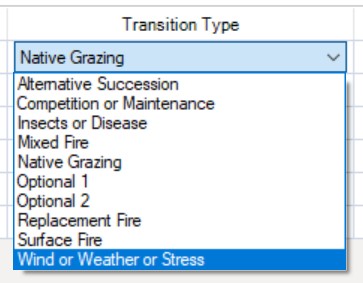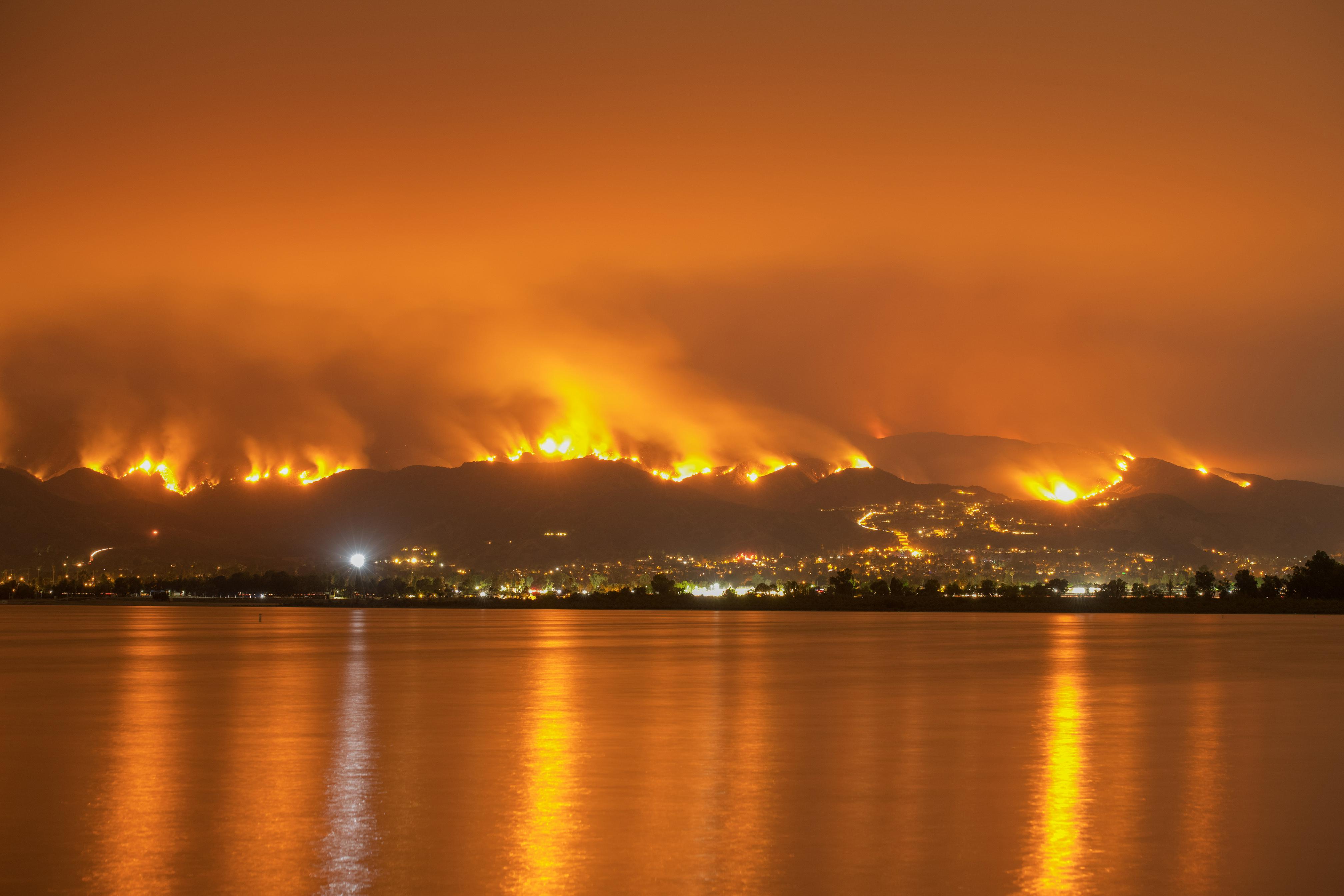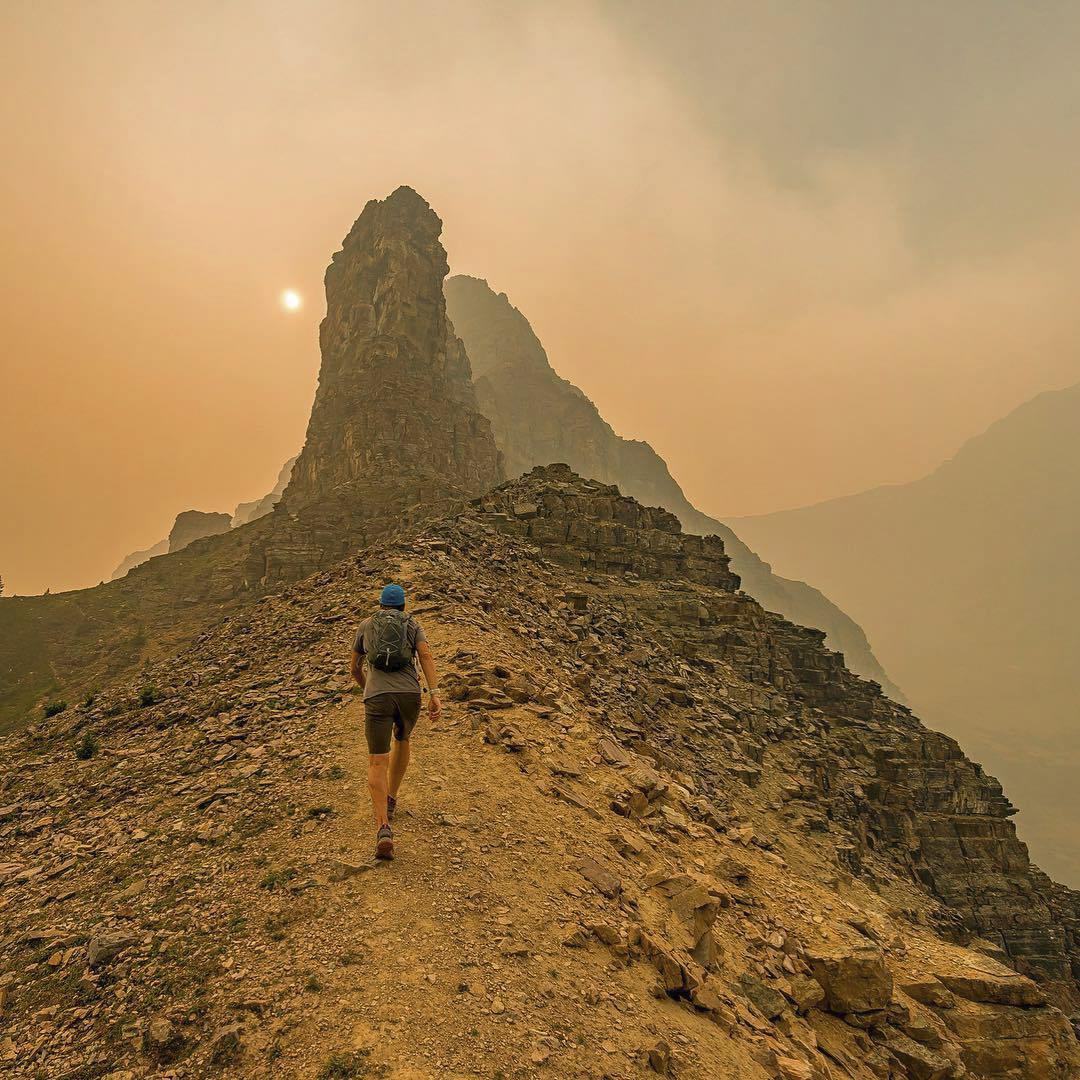Climate Change
This page:
- Context about climate change and ecosystem impacts
- Ways that BpS models can enhance understanding of potential responses of ecosystems to climate change
- Examples of how to alter disturbances and states to explore potential climate change impacts in the BpS modeling framework
Climate Change and STSM Modeling

Photo: © Marci Eggers, TNC.
The goal of this section is to help you identify questions that the LANDFIRE BpS models (with their built-in simplifications, strengths, and constraints) are best suited to help you explore.
Changes in climate, such as increases in temperature, changes in
precipitation patterns, and increases in evaporative demand are
influencing vegetation dynamics through many mechanisms operating at a
range of scales, from genes to biomes. Observed ecological responses
such as species range shifts, and changes in growth and mortality, in
addition to ecological theory, allow us to generate hypotheses on how
these changes may influence large-scale vegetation patterns. Many of
these hypotheses can be productively explored with BpS models in the
SyncroSim platform.
Before jumping into modeling, it is important to recognize that BpS models focus on vegetation communities, which presents some limitations in a climate change modeling context. Over evolutionary time, plant species have developed traits that reflect the influence of climate, other abiotic factors, and species interactions such as competition for resources. The suite of species that make up an ecosystem are likely to respond differently to climate change. While growth and mortality transitions for vegetation classes can easily be modified with these models, questions that focus on changes in species dynamics or changes in composition within a vegetation class, are more appropriate for species-focused models.
The “sweet spot” for LANDFIRE BpS models in a climate change context is exploring how climate change can influence disturbance regimes, and as a result influence the relative proportion of each ecosystem state over time. These tools allow users to consider the influence of processes that occur across a wide range of frequencies, including time periods much longer than human experience. By iterating through a series of models with different settings, you can illuminate how climate-linked events with different frequencies can interact to shape the distribution of vegetation classes on the landscape, and gain an understanding of the sensitivity of these patterns to observed and projected climate-related changes.
Climate change and BpS models
As described on the Vegetation Modeling page, LANDFIRE BpS models are comprised of a set of states and transitions. Each state is a recognizable seral stage or “condition” of a particular vegetation type, and these states are linked by deterministic transitions (usually representing growth towards an older, taller age class), and stochastic transitions representing disturbances such as fire, windthrow, and “weather stress” which can be used to represent drought, insect outbreaks, and other factors. These transitions describe how one vegetation state changes to a different state, and while the default values represent historic reference conditions, you can update them to represent current and future climates. Using the Inter-Mountain Basins Montane Sagebrush Steppe BpS as an example, a first step might be to just explore what happens to model outputs when you change the disturbance rates. Wildfire and drought are typical disturbances in this ecosystem, as indicated by the transition icons above and below the states in the model shown below.
Exploring climate change impacts may involve modifying the disturbance frequencies in a systematic way, following the current model structure. You might increase the rate of drought by increasing the drought probability value for the two drought transitions shown along the top.
Reading the BpS model description can provide important background on ranges from the literature that can form the basis for these explorations, as there may be variation across locations that provides a starting point for developing a range of values to compare. . You can always build a model that goes outside of the currently observed range of disturbance rates as a way of exploring what might happen as climate continues to change. However, as values become more extreme, note that you are getting into a zone of higher and higher model uncertainty; in the real world the probability that the overall system might change will likely increase. For example, if fire frequencies become very high, one or more seral stages may transition to a different kind of vegetation. In the slides below, we illustrate a simple set of simulations where we double the frequency of drought, then double the frequency of fires, and then run a model where we double the rate both disturbances. The details on how to change these transition values are described on the Modeling Work page.
Click through the slides below to explore ways you might explore climate change impacts in a sagebrush-steppe ecosystem:
You will notice in the plot of drought frequency that the probability of drought stays the same every year – each pixel has the same “odds” of being hit by drought based on this mean value. Drought conditions typically show high variation across years, with occurrences synchronized across large areas. To produce a more realistic model, you could work in the “advanced” mode to incorporate a variable pattern of drought frequencies, and then increase the rates using a temporal multiplier.
For this example, information on the drought and fire sensitivity of the dominant species, Mountain big sagebrush, from across its current range could help you frame these types of model modifications In BpS models with a more diverse set of co-dominant species, such as mixed hardwood forests of the southern Appalachians, the transition rates and time steps represent an average across multiple species in the vegetation community. This does not mean that you can’t gain insight by exploring climate change drivers with these models, but it is important to remember that different species are likely to respond to climate drivers in unique ways.
Reviewing the tools
In the section below, we briefly review the windows in SyncroSim where you make basic changes to BpS models.
Altering disturbances

Screenshot of Transition Types
- Adding or removing a type of disturbance. Note there is not a specific “drought” factor, so it can be captured under “Wind or Weather or Stress.”
- Modifying the intensity, or distribution across intensity levels (e.g., low, med, high)
- Changing the rate (probability) directly
- Incorporating a rate multiplier, which allows the probability of a disturbance to change over time.
Altering states
- Adding or removing vegetation classes (i.e., adding a new grass-dominated state that might be expected if fire frequencies in a forest or shrubland become very high, or adding an invasive plant species that is favored by some aspect of climate change)
- Slowing down or speeding up succession to represent a change in growth rates, or slower recovery
- Transitioning a vegetation class to a new BpS

Screenshot of Transition Types
Additional Examples
More intense fires
Increases in the intensity of fires is a trend that has been observed in forests with high vegetation density, often in combination with drought. To represent this process, you would increase the probability of high intensity fires in your model – or potentially add this type of disturbance if it was not already in the model.

© Ben Jiang, TNC. One of the 2018 California wildfires.
Longer fire seasons
Cattau et al. 2020 describe an extension of the duration of the fire season due to climate-related shifts in the timing of natural ignition source- and human-caused fires. Modeling this change would involve decreasing the fire return interval (i.e., increasing the probability).

© Chris Helzer, TNC. Niobrara River near the headquarters of The Nature Conservancy’s Nebraska Niobrara Valley Preserve after the 2012 wildfire.
Larger fires
Similarly, as climate continues to change we are seeing an increase in the spatial extent of fires. In the aspatial LANDFIRE BpS models, you can simulate this in the same way as you would model an increase in fire frequency – by using a higher fire frequency value. As a result of using the same approach for both patterns (larger fires, and more frequent fires), it is not possible to separate out impacts in the aspatial models. With spatial models, you can add this additional complexity.

© Stavros Mitchelides, TNC Photo Contest 2019. Dense wildfire smoke in Banff National Park
Insect outbreaks
Insect outbreaks that promote a state change in vegetation are not found in all of the “out of the box” BpS models, but you can always add this transition. Insect outbreaks can be added and varied in all of the ways described above for fire.
Transitions in vegetation classes

© Devan King/TNC
In some vegetation systems, managers have observed that increases in the intensity or extent of fires is leading to a failure of the ecological system to regenerate – reasons may include a lack of seed sources close to the newly burned area. This observation could be modeled by adding a new vegetation class (perhaps a grass or shrub class), then transitioning some (using the proportion field) or all of the burned cells to this new class.
While BpS models are aspatial as delivered, you can capture that variation by developing separate iterations of the same model if you have information on how vegetation dynamics might vary within an assessment area. For example, site conditions may strongly influence the sensitivity of a system to a disturbance, the rate of recovery after a disturbance, or the probability that a disturbance will shift a vegetation type to a new class.
Increasing model complexity
Changes in climate factors can influence ecosystems in multiple ways, with some drivers potentially interacting with each other. While climate change impacts are complex, this does not mean you should try to capture the full range of complexity in your model, especially not in the first steps of model exploration. For example, the interaction between drought, insect outbreaks, and fire is a multi-factor, climate-related driver of change in forested ecosystem, especially notable now in the western U.S. You could take an existing BpS model and add or modify drought, fire, and insect probabilities separately, especially if differences in site conditions across the focal forest suggest that that there may be different response trajectories. However, we suggest at least starting your modeling work by treating this complex set of drivers as one disturbance.
BpS model limitations in a climate context
In the section above, we point out the challenge of separating out impacts of increasing fire size and increasing fire frequency – this is not feasible with an aspatial model. We also described how, as delivered, models that include drought (weather stress) are also not capturing temporal variability and spatial correlation, though you can address some of these issues with advanced settings.
Similarly, because BpS models operate at the ecological level of vegetation communities, species-level responses are not well addressed in most models. Due to this focus on vegetation classes, and the fact that they are aspatial, LANDFIRE BpS models are not well-suited for evaluating species range shifts, or exploring changes in species composition that might occur as a result of changes in tree competitive ability as growing seasons lengthen due to a warming climate. BpS models are not the best hammer for every nail! As with modifying any model, it is important to consider the original intent and structure, and work within those constraints.
What’s next?
- explore 3 real-life model examples that have undergone scrutiny and analysis by the LANDFIRE team
- learn the intricacies of examining each model description